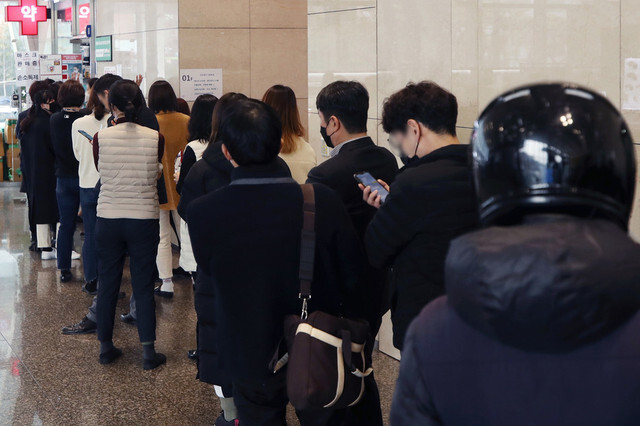hankyoreh
Links to other country sites 다른 나라 사이트 링크
More S. Koreans feel angry at coronavirus news as situation prolongs

With fears growing among the general public over 40 days after the novel coronavirus began spreading in South Korea, the number of people describing themselves as feeling “angry” when they see related news has more than tripled, survey findings show. The results also indicated increased trust in the Korea Centers for Disease Control and Prevention (KCDC) but growing distrust of the Blue House and media in terms of their response to the virus.
On Mar. 4, a research term led by You Myoung-soon, professor at the Seoul National University Graduate School of Public Health, published findings from a “second survey of the South Korean public’s risk perceptions” based on responses from 1,000 people nationwide between Feb. 25 and 28. The findings showed 85.1% reporting feeling “increased anxiety in the month since the first confirmed diagnosis.” When asked about their “feelings upon encountering news about the novel coronavirus,” the most frequent response was “anxiety” (48.8%), although the percentage was down from the 60.2% recorded when the first survey was conducted roughly a month earlier between Jan. 31 and Feb. 4.
The emotion that showed the most notable increase in the latest survey was “anger” at 21.5%, or more than triple the 6.8% recorded in the first survey. The percentage of respondents naming “shock” rose slightly from 10.9% to 12.6%, while reports of “fear” were down from 16.7% to 11.6%. Reports of experiencing anger were found to be relatively higher among respondents in their 20s and those in the Daegu/North Gyeongsang Province region.
“The emotions South Koreans are experiencing now are different from those when the disease first surfaced,” You said of the findings.
“It appears that the anxiety people are feeling about the number of deaths rising, being unable to find the masks that have been recommended as a key means of prevention, and hearing reports of people not observing the self-quarantine rules has combined with feelings of discontentment and distrust,” she suggested.
“We need more finely tuned and differentiated forms of crisis communication,” she concluded.
Among the public institutions responding to the virus, trust in the KCDC was found to have increased. Among respondents in the latest survey, 81.1% said that they “trust” the KCDC, a 6.5-percentage point increase from the first survey. Trust in public health care institutions such as national university hospitals and local medical centers was also up from 72.6% to 79.3%, while trust in local governments rose slightly from 52.5% to 55.4%.
At the same time, 49.5% of respondents said they “trust” the Blue House, an 8.1-percentage point decrease from the first survey, and 39.9% expressed trust in the media, a 6.5-percentage point decrease.
A majority 70.5% of respondents agreed that the government had made an appropriate decision in increasing the infectious disease crisis alert level to “severe” on Feb. 23, while only 40.8% predicted that the measure would lead to an “early end” to the coronavirus outbreak. In contrast, 74.5% agreed that it signaled a “long-term battle” with the disease. Regarding these findings, You suggested, “It may be important for the government to adopt a strategy of achieving ‘small victories’ by achieving continued results, however small they are.”
By Park Jun-yong, staff reporter
Please direct comments or questions to [english@hani.co.kr]

Editorial・opinion
![[Column] Season 2 of special prosecutor probe may be coming to Korea soon [Column] Season 2 of special prosecutor probe may be coming to Korea soon](https://flexible.img.hani.co.kr/flexible/normal/500/300/imgdb/original/2024/0426/3317141030699447.jpg) [Column] Season 2 of special prosecutor probe may be coming to Korea soon
[Column] Season 2 of special prosecutor probe may be coming to Korea soon![[Column] Park Geun-hye déjà vu in Yoon Suk-yeol [Column] Park Geun-hye déjà vu in Yoon Suk-yeol](https://flexible.img.hani.co.kr/flexible/normal/500/300/imgdb/original/2024/0424/651713945113788.jpg) [Column] Park Geun-hye déjà vu in Yoon Suk-yeol
[Column] Park Geun-hye déjà vu in Yoon Suk-yeol- [Editorial] New weight of N. Korea’s nuclear threats makes dialogue all the more urgent
- [Guest essay] The real reason Korea’s new right wants to dub Rhee a founding father
- [Column] ‘Choson’: Is it time we start referring to N. Korea in its own terms?
- [Editorial] Japan’s rewriting of history with Korea has gone too far
- [Column] The president’s questionable capacity for dialogue
- [Column] Are chaebol firms just pizza pies for families to divvy up as they please?
- [Column] Has Korea, too, crossed the Rubicon on China?
- [Correspondent’s column] In Japan’s alliance with US, echoes of its past alliances with UK
Most viewed articles
- 1No good, very bad game for Korea puts it out of Olympics for first time since 1988
- 2[Column] Season 2 of special prosecutor probe may be coming to Korea soon
- 3Korea’s 1.3% growth in Q1 signals ‘textbook’ return to growth, says government
- 4‘We must say no’: Seoul defense chief on Korean, USFK involvement in hypothetical Taiwan crisis
- 5Is N. Korea threatening to test nukes in response to possible new US-led sanctions body?
- 6Division commander ordered troops to enter raging flood waters before Marine died, survivor says
- 7[Column] ‘Choson’: Is it time we start referring to N. Korea in its own terms?
- 8Will NewJeans end up collateral damage in internal feud at K-pop juggernaut Hybe?
- 9Korea sees more deaths than births for 52nd consecutive month in February
- 10[Editorial] Korea’s surprise Q1 growth requires objective assessment, not blind fanfare